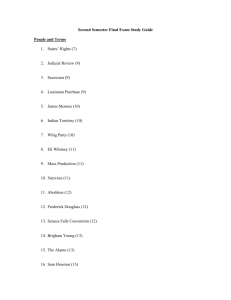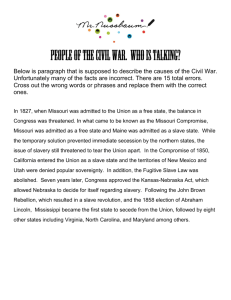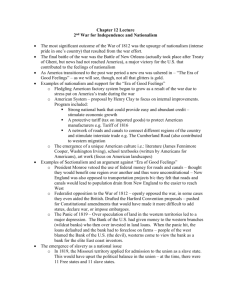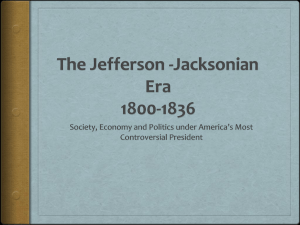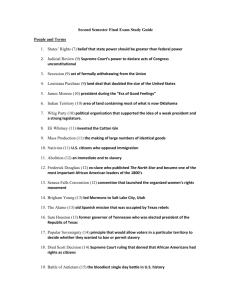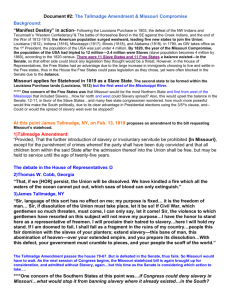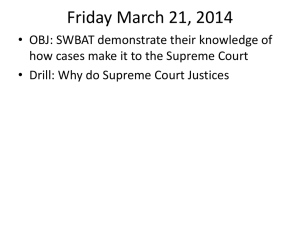Life in the Thirteen English Colonies
advertisement
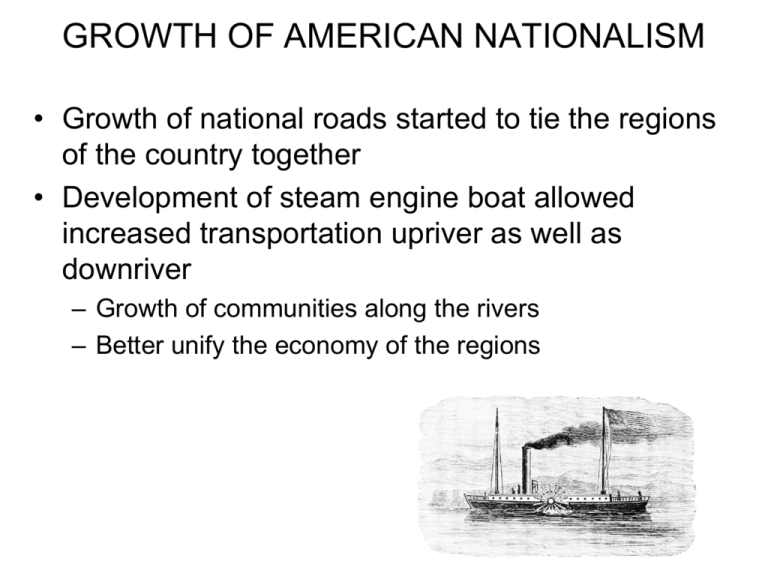
GROWTH OF AMERICAN NATIONALISM • Growth of national roads started to tie the regions of the country together • Development of steam engine boat allowed increased transportation upriver as well as downriver – Growth of communities along the rivers – Better unify the economy of the regions SUPREME COURT AND NATIONALISM • John Marshall used the Supreme Court to further grow the power of the federal government • McCulloch v. Maryland – State of Maryland tried to tax the Bank of the U.S. – Ruling: The national bank was constitutional due to implied powers – States cannot tax a federal institution • Gibbons v. Ogden – State of New York granted a monopolistic contract for water trade on the Hudson between NY and NJ – Ruling: Congress controls interstate commerce – Contract unconstitutional, limit of state power SUPREME COURT AND NATIONALISM • Fletcher v. Peck – One state legislature sold land to private speculators, the next legislature canceled the contract – Ruling: Congress controls contracts and states cannot try to limit contract rights, protection of property rights – The Supreme Court can overrule state laws that conflict with the Constitution • Dartmouth College v. Woodward – College given charter by King George III but state legislature wanted to change / cancel – Ruling: The charter was a contract, protected by the Constitution – Protection to business, but later became a problem because of abuse by monopolies (trusts) TREATIES EXPANDING THE COUNTRY • Rush-Bagot Treaty (1817) – The U.S. and Canada demilitarized the border between the two countries – Still today the longest unprotected border in the world • Convention of 1818 – (1) Set the northern border of the Louisiana Territory at the 49o parallel (2) 10-year joint occupation by U.S. and England of the Oregon country (c) fishing rights in Newfoundland • Adams-Onis Treaty (1819) – Spain could no longer support occupation of Florida from the U.S. – (1) Gave up Florida (2) gave up claims to the Oregon country MONROE DOCTRINE • President Monroe’s response to European moves into the Americas – Russia was pushing down the western coastline from Alaska – New countries in South America in danger from their old rulers as well as other Europeans who might try to push into the countries while they were still weak • Statement made during his 1823 State of the Union address to Congress • Two parts to the statement: – Non-Interference: Europeans should not interfere in affairs in the Western Hemisphere – Non-involvement: The U.S. would not become involved in affairs in Europe, especially revolutions MISSOURI COMPROMISE • Missouri wanted to enter the Union as a slave state – First new state from the Louisiana Territory region • New abolition movement in the North saw this as a spread of slavery into the new territories – Tallmadge Amendment tried to limit long-term growth of slavery by freeing all slaves at 25 years of age • Both North and South worried about sectional balance in the Senate (where it is 2 senators / state) • Threat of secession by some Southerners worried nationalists who did not want to see the country breaking apart http://faculty.umf.maine.edu/~walters/web%20233/missouri%20compromise%20map%202.jpg MISSOURI COMPROMISE • Agreement reached that temporarily solved problems • Decisions made: – Missouri entered the Union as a slave state – Maine entered the Union as a free state – Slaves states would not be allowed north of the 36-30 line • Territories south of line could still enter the Union as slave states • States already north of line remained slave states • Allowed country to settle issue of slavery, begin further expansion westward • Later, the limits placed on the South would become a problem Southern gains and losses: Short term vs. Long term • • • • SHORT TERM FLORIDA gained MISSOURI gained north of the line ARKANSAS gained Balance of power retained in the Senate • • • • LONG TERM Expansion into northern Louisiana Territory lost Michigan lost Access to a Pacific trade route lost Balance of power in Senate threatened as country expanded
